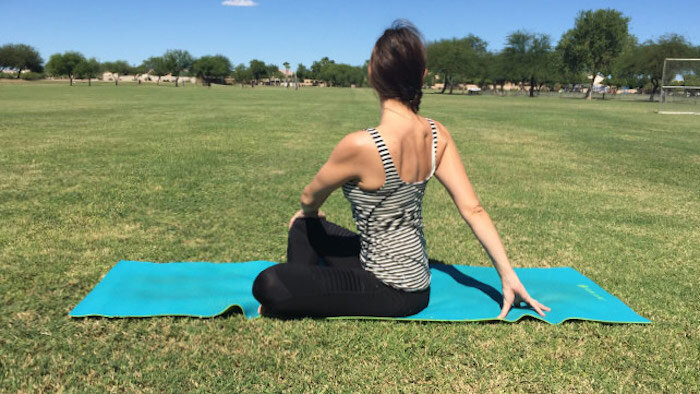
Pain in the upper and/or middle back can be quite limiting and interfere with daily activities. To help alleviate this pain, consider stretching and strengthening the muscles that support your thoracic spine (upper and mid-back). Here are 5 common exercises to try.
Press-Up Exercise
This press-up or back extension exercise targets your back extensor muscles, which are attached to the back of your spine.
- Lie on the stomach with your hands under your shoulders.
- Raise your upper body onto your elbows while keeping both forearms and hips relaxed on the ground. Breathe out and allow your chest to sink toward the ground. You should feel a comfortable stretch in your mid-back.
- Hold for 5 seconds, then slowly return to the floor.
- Aim to complete 10 repetitions. Gradually build to hold the position for 30 seconds.
A more advanced Step 2 involves raising your upper body onto your hands (rather than forearms) while still keeping both hips relaxed on the ground. In yoga, this is called the cobra pose.
Cat-Cow Pose
The cat-cow pose is a gentle stretch that can help ease the pain in your middle back.
- Get down on all fours with knees and hands on the floor. The back and neck should be in a neutral, straight position.
- Slowly tighten lower abdominals, rounding the back towards the ceiling and tucking your chin. You should feel a stretch along your spine.
- Hold for 5 seconds.
- Release and return to the neutral position.
- Slowly lift your head, chest, and tailbone toward the ceiling, letting your spine and stomach sink toward the ground. This should also produce a comfortable stretch in your spine.
- Hold for 5 seconds.
- Release and return to the neutral position.
Alternate between the two poses.
Opposite Arm/Leg Raise
This exercise, sometimes called the bird-dog pose in yoga, strengthens your abdominals and back muscles.
- Get on your hands and knees. Keep your spine straight, with your hands directly below your shoulders and your knees aligned directly under your hips.
- Slowly reach out with one arm while extending the leg on its opposite side. Keep both straight and level.
- Hold for a few deep breaths, then gently lower your arm and leg to starting position.
- Repeat this exercise with your other arm/leg.
- If you had a tissue box balanced on your lower back it should remain in place throughout the exercise.
Try for 10 to 15 repetitions on each side.
Corner Stretch
Upper back pain is often due to poor posture, which may be exacerbated by tight chest muscles. The corner stretch is an easy and effective way to open up the chest muscles and encourage healthy posture.
- Face the corner of a room.
- Position feet together, about 2 feet away from the corner.
- Place a forearm on each wall with the elbows slightly below shoulder height.
- Lean forward until a good stretch is felt across the chest and shoulders. Your lower back should remain neutral (as it is while standing).
- Hold the stretch for 30 to 60 seconds.
If a corner is not available, another option is to perform this stretch in a doorway by placing the forearms on the door jambs (sides of the door frame). This stretch can be performed 3 to 5 times throughout the day.
Prone Cobra
The prone cobra is an advanced back extension exercise that targets your upper back muscles:
- Lie on the floor face down. You may place the forehead on a rolled-up hand towel for comfort.
- Place the arms at the side, palms down on the floor
- Pinch the shoulder blades together and lift the hands off the floor. Keep shoulders down and away from ears.
- Roll the elbows in, palms out, and thumbs up.
- Gently lift the forehead about an inch off the towel keeping the eyes looking straight at the floor (do not tip the head back and look forward).
- Try to hold the position for 10 seconds.
- Aim to complete 10 repetitions.
To increase the intensity slightly, you can lift your legs off the ground, too.
Exercise should push your body (whether a feeling of stretch or fatigue) but not leave you feeling increased symptoms at rest. Stop immediately and consult with your health care provider if any of these exercises increase or cause pain. A physiatrist, physical therapist, or another qualified health professional can create an exercise plan specifically tailored to treat your symptoms and underlying condition.
Precision Pain Care and Rehabilitation has two convenient locations in Richmond Hill – Queens and New Hyde Park – Long Island. Call the Richmond Hill office at (718) 215-1888, or (516) 419-4480 for the Long Island office, to arrange an appointment with our Interventional Pain Management Specialist, Dr. Jeffrey Chacko.













